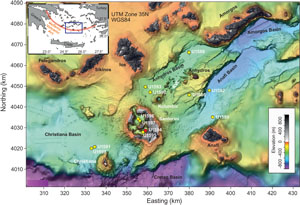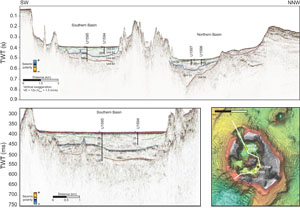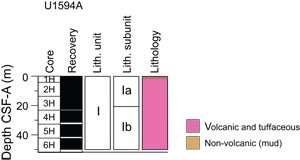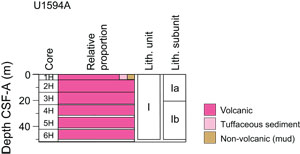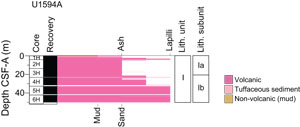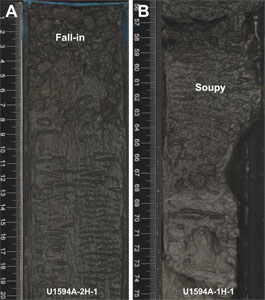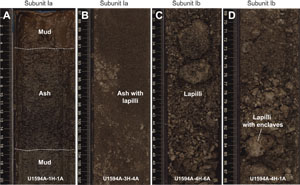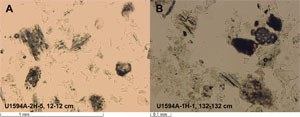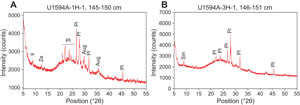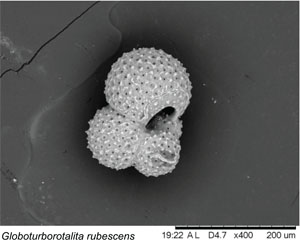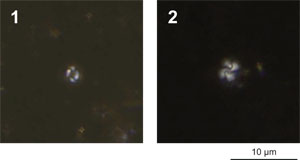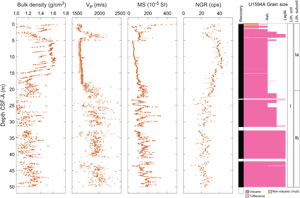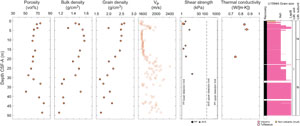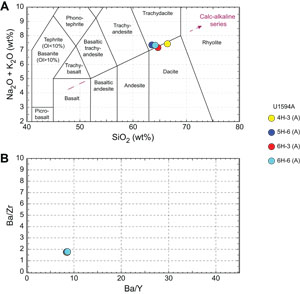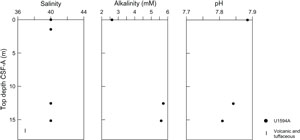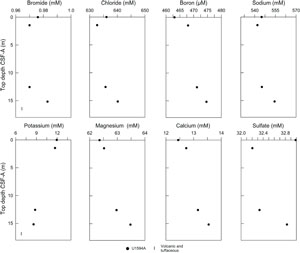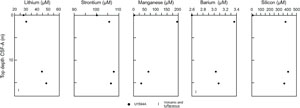Druitt, T.H., Kutterolf, S., Ronge, T.A., and the Expedition 398 Scientists
Proceedings of the International Ocean Discovery Program Volume 398
publications.iodp.org
https://doi.org/10.14379/iodp.proc.398.108.2024
Site U15941
![]() S. Kutterolf,
S. Kutterolf,
![]() T.H. Druitt,
T.H. Druitt,
![]() T.A. Ronge,
T.A. Ronge,
![]() S. Beethe,
S. Beethe,
![]() A. Bernard,
A. Bernard,
![]() C. Berthod,
C. Berthod,
![]() H. Chen,
H. Chen,
![]() S. Chiyonobu,
S. Chiyonobu,
![]() A. Clark,
A. Clark,
![]() S. DeBari,
S. DeBari,
![]() T.I. Fernandez Perez,
T.I. Fernandez Perez,
![]() R. Gertisser,
R. Gertisser,
![]() C. Hübscher,
C. Hübscher,
![]() R.M. Johnston,
R.M. Johnston,
![]() C. Jones,
C. Jones,
![]() K.B. Joshi,
K.B. Joshi,
![]() G. Kletetschka,
G. Kletetschka,
![]() O. Koukousioura,
O. Koukousioura,
![]() X. Li,
X. Li,
![]() M. Manga,
M. Manga,
![]() M. McCanta,
M. McCanta,
![]() I. McIntosh,
I. McIntosh,
![]() A. Morris,
A. Morris,
![]() P. Nomikou,
P. Nomikou,
![]() K. Pank,
K. Pank,
![]() A. Peccia,
A. Peccia,
![]() P.N. Polymenakou,
P.N. Polymenakou,
![]() J. Preine,
J. Preine,
![]() M. Tominaga,
M. Tominaga,
![]() A. Woodhouse, and
A. Woodhouse, and
![]() Y. Yamamoto2
Y. Yamamoto2
1 Kutterolf, S., Druitt, T.H., Ronge, T.A., Beethe, S., Bernard, A., Berthod, C., Chen, H., Chiyonobu, S., Clark, A., DeBari, S., Fernandez Perez, T.I., Gertisser, R., Hübscher, C., Johnston, R.M., Jones, C., Joshi, K.B., Kletetschka, G., Koukousioura, O., Li, X., Manga, M., McCanta, M., McIntosh, I., Morris, A., Nomikou, P., Pank, K., Peccia, A., Polymenakou, P.N., Preine, J., Tominaga, M., Woodhouse, A., and Yamamoto, Y., 2024. Site U1594. In Druitt, T.H., Kutterolf, S., Ronge, T.A., and the Expedition 398 Scientists, Hellenic Arc Volcanic Field. Proceedings of the International Ocean Discovery Program, 398: College Station, TX (International Ocean Discovery Program). https://doi.org/10.14379/iodp.proc.398.108.2024
2 Expedition 398 Scientists’ affiliations.
1. Background and objectives
Site U1594 (proposed Site CSK-07B) is located in the southern basin of Santorini caldera at a water depth of 291 meters below sea level (mbsl) (Figure F1). It was drilled to a maximum recovery depth of 50.1 meters below seafloor (mbsf) in a single hole (U1594A) with 93% recovery before hole instability set in and the hole was terminated (all depths below seafloor are given using the core depth below seafloor, Method A [CSF-A] scale, except in Operations where the drilling depth below seafloor [DSF] scale is used). Site U1595 addresses the same drilling objectives and lies southwest of Site U1594. Two additional sites (U1596 and U1597) lie in the northern caldera basin.
Four seismic units have been recognized in the caldera (Johnston et al., 2015; Nomikou et al., 2016) (Figure F2). They were thought to consist of muds and sands from cliff mass wasting (Seismic Unit S1); compacted (possibly lithified) sandy volcaniclastics from Kameni Volcano (Unit S2); and consolidated coarse blocky intracaldera tuffs, landslide debris, and/or flood gravels (Unit S3). Unit S4 was thought to be intracaldera tuff from the Late Bronze Age eruption. The four caldera sites were planned to sample Units S1–S3; test the published correlations between the two caldera basins; penetrate below Unit S3 into Unit S4; and address scientific Objectives 1, 4, 5, and 7 of the Expedition 398 Scientific Prospectus (Druitt et al., 2022). By drilling both caldera basins and exploiting our dense seismic reflection coverage, we gained access to the 3D architecture of the entire caldera fill. We also targeted the question of why the northern basin is 100 m deeper than the southern one. Finally, we tested whether Unit S3 consisted of flood debris from the caldera flooding event (Nomikou et al., 2016) or was Late Bronze Age intracaldera tuff (Johnston et al., 2015). The intracaldera sites were used for microbiological work of scientific Objective 7.
2. Operations
On 22 January 2023 at 1830 h, the vessel arrived at Site U1594 at the southern end of the Santorini caldera. All thrusters were down and secured at 1848 h. The vessel was switched to dynamic positioning control, and Site U1594 was started at 1850 h (all times local; 2 h ahead of UTC). The 15.0 nmi transit took 1.8 h at an average speed of 8.3 kt.
2.1. Hole U1594A
Once given the all clear, the rig crew made up an advanced piston corer/extended core barrel (APC/XCB) bottom hole assembly (BHA) with a bit. Hole U1594A (36°23.3368′N, 25°25.0290′E) was spudded on 22 January 2023 at 2310 h. The core was shot from 297.0 meters below rig floor, with a recovery of 4.2 m, establishing the seafloor at 291.0 mbsl (Table T1).
APC coring continued on 23 January with Cores 2H (4.2 mbsf) through 6H, with the bottom at 51.7 mbsf, the final depth for Hole U1594A. Excessive torque was observed, indicating a collapsing hole. The driller worked the drill string, but the tight conditions persisted. The drill string was pulled up with the top drive from 42.2 mbsf to ~100 m above seafloor. The bit cleared the seafloor at 0350 h.
The decision was made to move the vessel to an alternate offset site in the southern caldera (Site U1595). The vessel was moved in dynamic positioning mode, starting the 0.7 nmi passage at 0445 h and marking the end of Site U1594.
3. Lithostratigraphy
Cores from Site U1594 recovered a coherent stratigraphy from 0 to 50.09 mbsf (Sections 398-U1594A-1H-1 through 6H-6) (Figure F3). The site consists only of Hole U1594A.
The recovered material is unlithified sediment dominated by volcanic material with minor amounts of mud and tuffaceous mud in the uppermost 1.5 m. Smear slides for microscopic analyses were prepared to confirm macroscopic descriptions of distinct lithology changes at the section level, such as identification of vitric ash particles in tuffaceous lithologies or crystals in ash layers. X-ray diffraction (XRD) data were obtained from three interstitial water (IW) squeeze cake sediment residues from Hole U1594A.
Figure F3 summarizes the lithostratigraphy of Site U1594, displaying core recovery and lithostratigraphic unit and subunits. Table T2 provides the upper and lower boundaries and thicknesses and lithologic summaries of the unit and subunits. Figure F4 graphically presents the relative proportions of volcanic, tuffaceous, and nonvolcanic lithologies in Hole U1594A, and Figure F5 presents the grain size distribution of the sediments, in particular the changes in grain size in the volcanic-dominated unit, to graphically show the distribution of ash, lapilli-ash, and lapilli. Figure F6 displays different types of core disturbance observed at Site U1594.
The following sections describe (1) the effects of core disturbance, (2) the lithostratigraphic unit and subunits, and (3) XRD results from Site U1594.
3.1. Core disturbance
The following types of core disturbance disrupt the lithostratigraphy at Site U1594 (Figure F6):
- Fall-in: coarse clast-supported or, in some cases, finer grained muddy intervals at the tops of many cores (Figure F6A). In these intervals, which may reach up to 16 cm in thickness, original lithofacies and sedimentary structures are usually slightly disturbed and not fully destroyed.
- Soupy: typically restricted to water-saturated intervals of unconsolidated ash overprinting original sedimentary or depositional structures (Figure F6B).
- Artificial size and density segregation: likely to occur during drilling or with postrecovery core handling processes on board (e.g., inclining, shaking, and plunging cores on the catwalk to compact sediments). Jutzeler et al. (2014) also described pseudohorizontal density grading that can occur while the core is lying flat on deck, resulting in vertical structures once the core is turned upright. Such core disturbance is observed most often in volcanic sediments because increased porosity allows sucking in of seawater during hydraulic piston coring. The resulting soupy texture allows material to flow within the core liner. Secondary normal or reverse grading, or density separation of clasts, may occur as a result of this disturbance and obscure primary sedimentary features.
3.2. Description of unit and subunits
3.2.1. Unit I
- Interval: 398-U1594A-1H-1, 0 cm, to 6H-6, 89 cm (bottom of the hole)
- Depth: 0.00–50.09 mbsf
- Thickness: >50.09 m
- Age: Holocene
- Lithology: volcanic lithologies (ash, lapilli-ash, and lapilli), minor tuffaceous sediment (tuffaceous mud), and nonvolcanic sediment (mud)
Unit I is the only lithostratigraphic unit in Hole U1594A, extending from 0 to 50.09 mbsf (Table T2). It consists predominantly of volcanic lithologies (>75% volcanic particles; glass shards, pumice, scoria, and crystals) with small amounts of tuffaceous sediment (25%–75% volcanic particles) and nonvolcanic sediment (<25% volcanic particles) (Figure F4).
Volcanic lithologies comprise ash, lapilli-ash, and lapilli. Description of these lithologies in volcanic intervals was based on the relative abundance of ash-sized (<2 mm) and lapilli-sized (2–64 mm) particles, as described in Lithostratigraphy in the Expedition 398 methods chapter (Kutterolf et al., 2024). Ash and lapilli were used when the proportion of one grain size was >75%, and lapilli-ash was used when both grain sizes were present but at <75% abundance (Fisher and Schmincke, 1984). Tuffaceous sediments comprise tuffaceous mud, whereas nonvolcanic sediments are muds that may be organic rich.
Subunits in Unit I were defined primarily by a distinct change of the volcanic lithologies and grain size and a distinct change in physical properties (see Physical properties), including moisture and density (MAD), P-wave velocities, magnetic susceptibility (MS), and natural gamma radiation (NGR), as follows:
- Subunit Ia (Sections 398-U1594A-1H-1, 0 cm, through 3H-5, 100 cm; 0–20.74 mbsf): ash-dominated succession of volcanic lithologies with a minor amount of mud.
- Subunit Ib (Sections 3H-5, 100 cm, through 6H-6, 89 cm; 20.74–50.09 mbsf): lapilli-ash and lapilli-dominated succession with lesser ash.
3.2.1.1. Subunit Ia
Subunit Ia extends from 0 to 20.74 mbsf in Hole U1594A between Sections 1H-1, 0 cm, and 3H-5, 100 cm (Figure F3). It consists predominantly of volcanic lithologies (ash, lapilli-ash, and lapilli) with minor amounts of tuffaceous sediment (tuffaceous mud) and nonvolcanic sediment (mud) in the uppermost part of the succession (Figure F7A, F7B). Subunit Ia starts with 51 cm of brown organic-rich mud and gray mud with an intercalated 12 cm thick gray ash layer. This is followed by intervals of volcanic lithologies of ash, lapilli-ash, and lapilli, the majority of which are dominated by well-sorted olive-gray to very dark gray ash. Coarser grained volcanic intervals comprise moderately to poorly sorted grayish brown to very dark gray lapilli-ash and lapilli, with maximum grain sizes of medium to coarse lapilli. Pumice clasts are typically subangular with white, tan, dark brown, and dark gray varieties, often with lighter colored surfaces. Scoria clasts were described in two intervals of Subunit Ia. An interval of tuffaceous mud occurs at the lowermost part of Section 1H-1. The uppermost ash layers in this subunit are well sorted and very dark gray ash. Below this, intervals of ash are typically grayish brown in color, characterized by grain sizes ranging from fine to coarse ash, and moderately to poorly sorted. Minor amounts of dispersed light-colored subangular and medium and coarse pumice lapilli occur in most ash intervals. A 7 cm thick layer of light-colored pumice lapilli with ash is interspersed within an ash interval at 17.42–17.49 mbsf.
Selected smear slides show representative lithologies of Subunit Ia. Microscopically, ash layers are characterized by colorless blocky to cuspate and pumiceous glass shards (Figure F8A). Vesicles are typically elongated to tubular and, in rare cases, round. Crystals of plagioclase and opaques, and rare pyroxene, are also present. Lithic fragments are typically volcanic or sedimentary. Tuffaceous mud is characterized by blocky to pumiceous transparent glass, crystals such as plagioclase and rare pyroxene, biogenic clasts (e.g., foraminifera, diatoms, and sponge spicules), calcareous nannofossils, and lithic clasts of sedimentary and volcanic rock (Figure F8B).
3.2.1.2. Subunit Ib
Subunit Ib extends from 20.74 to 50.09 mbsf in Hole U1594A (Figure F3). Because the bottom was not recovered, the total thickness of this subunit is >33.37 m. Subunit Ib is entirely volcanic lithologies, consisting of lapilli-ash and lapilli with lesser ash (Figure F7C, F7D). The top of Subunit Ib is recognized by a distinct change from ash-dominated lithologies in Subunit Ia to brown to grayish brown coarse lapilli–dominated lithologies of Subunit Ib. This subunit boundary is also marked by a distinct change in bulk density, P-wave velocities, MS, and NGR (see Physical properties). Bulk density decreases significantly at the subunit boundary, whereas the decrease in NGR across the boundary is more gradual. P-wave velocities and MS also display a sharp change at the subunit boundary, becoming strikingly more scattered but, on average, higher in Subunit Ib.
Lapilli-ash and lapilli intervals are grayish brown and consist of subrounded to subangular pumice lapilli. These are typically brownish or gray to dark gray, with lighter colored and black pumice clasts present in some intervals. They have a vesicular to highly vesicular texture, with vesicle shapes ranging from elongate to tubular. Banded pumices, characterized by dark-colored bands in light-colored or brown pumice, and small mafic enclaves are common in some intervals.
No smear slides were prepared for Subunit 1b.
3.3. X-ray diffraction
XRD data were collected from three IW squeeze cake sediment residues from Hole U1594A. The analyzed samples comprise volcanic lithologies (ash) from Lithostratigraphic Subunit Ia only. XRD spectra of two ash samples are shown in Figure F9. As reported in previous site chapters, the volcanic ash samples from Hole U1594A show a characteristic hump at low °2θ, indicating the presence of volcanic glass. The only identified crystalline phases in the ash samples are Ca-rich plagioclase, augite, clay minerals of the illite group or smectite group (montmorillonite), and zeolite.
4. Stratigraphic correlation
Because only one hole was drilled, no stratigraphic correlation could be made at Site U1594.
5. Structural geology
No structures with measurable orientations were identified at Site U1594. Although there were some bedding planes, core-induced disturbance prevented orientation measurements.
6. Biostratigraphy
Planktonic and benthic foraminifera and calcareous nannofossils were examined from core catcher samples from Hole U1594A to assess the paleoenvironmental conditions of Site U1594.
Site U1594 cored the sedimentary sequence in the southeast portion of the Santorini caldera and recovered a 51.7 m thick sequence composed primarily of volcanogenic sediments. Very rare planktonic and benthic foraminifera are found in core catcher samples in the form of Globoturborotalita rubescens in Sample 398-U1594A-1H-CC, 0–8 cm (Table T3; Figure F10), and Sorites orbiculus in Sample 4H-CC, 9–10 cm (Table T4), respectively. Additionally, very rare occurrences of the calcareous nannofossils Emiliania huxleyi and Gephyrocapsa spp. (small form) are found in Sample 3H-CC, 10–11 cm (Table T5; Figure F11). This assemblage indicates an age of younger than 0.265 Ma (Raffi et al., 2006).
7. Paleomagnetism
None of the cores recovered at this site were suitable for paleomagnetic analysis.
8. Physical properties
There is a general trend of increasing P-wave velocity and MS with increasing depth at Site U1594. More than 40% of discrete samples have grain densities <2.0 g/cm3, and grain density decreases with increasing depth. Thermal conductivity is lower than typical values for sediments at similar depths.
8.1. Whole-round GRA density, MS, P-wave velocity, and NGR
Figure F12 summarizes data collected on whole-round cores using the gamma ray attenuation (GRA) densitometer, MS loop, and P-wave logger on the Whole-Round Multisensor Logger (WRMSL) as well as NGR. All cited depths are on the CSF-A scale. There are some systematic sources of error in these data that should be considered when interpreting absolute values and trends.
- Redistribution of unconsolidated volcaniclastic materials in core liners during coring and on the core retrieving platform can lead to sorting by particle size and density and, hence, changes in physical properties.
- Core liners sometimes contained large amounts of water. Thus, whole-round measurements in sections that match discrete measured values on split cores are most reliable.
Overall, there is a general trend of increasing P-wave velocity and MS and decreasing NGR with increasing depth.
8.2. Discrete measurements
8.2.1. Material strength
Sediment strength was measured with a pocket penetrometer (PP) on the catwalk immediately after section splitting. Automated vane shear (AVS) strength measurements were made on working-half sections. Because volcaniclastic materials are not suitable for these measurements, few measurements could be made (seven AVS and one PP) (Figure F13; Table T6).
8.2.2. P-wave velocity
A total of 130 P-wave velocity measurements were conducted on working-half sections (Figure F13; Table T7). Discrete measurements of P-wave velocity on working-half core sections are similar to those measured using the WRMSL on whole-round cores (Figure F12). A high P-wave velocity layer is located between 3 and 5 mbsf. P-wave velocity also increases with depth downhole. The large scatter below 20 mbsf arises from a combination of measurements that capture bulk sediment properties (lower values) and measurements made across a small number of lapilli clasts (larger values). For lapilli and larger sized clasts, the particle size was a substantial fraction of the distance between the two calipers used to make the measurements; hence, the measurements may not be representative of true bulk properties (i.e., sample size is not much larger than a representative elementary volume).
8.2.3. Moisture and density
A total of 17 discrete samples were collected for MAD measurements (Figure F13; Table T8). Bulk density derived by MAD measurements on discrete samples should be more reliable than GRA data from WRMSL measurements on whole-round cores, although in both cases coring and recovery disturbances may have impacted measured values.
Porosity ranges 51–80 vol% (mean = 66 vol%; standard deviation = 8 vol%). Bulk density ranges 1.2–1.6 g/cm3 (mean = 1.41 g/cm3). Bulk density does not obviously increase with depth.
Grain density ranges 1.6–2.6 g/cm3 (mean = 2.1 g/cm3; median = 2.1 g/cm3). A total of 41% of discrete samples have grain densities <2.0 g/cm3, and grain density decreases with increasing depth.
8.2.4. Thermal conductivity
A total of three thermal conductivity measurements were made on selected working-half sections (Table T9). Measurements could not be made on coarse, volcaniclastic materials; hence, the values we report are not representative of the full range of recovered lithologies. There is no apparent increase in thermal conductivity with increasing depth (Figure F13). Compared to typical sediments, in which thermal conductivity is close to 1 W/(m·K) at these depths below seafloor, thermal conductivity is low in volcaniclastic sediments at Site U1594.
9. Geochemistry
9.1. Volcaniclastic bulk geochemistry
To determine the geochemistry of the volcanic and tuffaceous materials, four tephra and ash samples were handpicked from various layers in Hole U1594A. Following cleaning, grinding, fusion, and dissolution, the materials were analyzed shipboard for major (Si, Al, Fe, Mg, and Ca), minor (Ti, Mn, Na, K, and P), and trace (Sc, V, Cr, Co, Ni, Cu, Zn, Rb, Sr, Y, Zr, Nb, Ba, Ce, and Nd) elements using inductively coupled plasma–atomic emission spectroscopy (ICP-AES) (see Geochemistry in the Expedition 398 methods chapter [Kutterolf et al., 2024] for analytical technique). Several unknown samples were run multiple times to determine analytical reproducibility.
9.1.1. ICP-AES: major, minor, and trace elements
All the volcaniclastic units sampled were classified as dacites or trachydacites (Table T10; Figure F14). Bulk chemistry values are less evolved than glass chemistry reported in Kutterolf et al. (2021), as expected, due to bulk analyses including both minerals and glass.
Concentrations are reported for all analyzed trace elements, but Ce, Cr, Cu, Nb, Ni, P, Rb, S, and V were below detection limits in the majority of samples and are not shown for respective samples in Table T10; volcaniclastic analytical errors are ±1% for major elements and ±5%–10% for trace elements (see Geochemistry in the Expedition 398 methods chapter [Kutterolf et al., 2024]). Trace element ratios were used to broadly discriminate between the volcanic centers of Kolumbo, Santorini, and Christiana.
9.2. Interstitial water geochemistry
To determine the inorganic constituents of IW, a total of four water samples were taken from the mudline and whole-round squeezing of sediment intervals at Site U1594. Aliquots of IW were used for shipboard analyses, and the remaining water was retained for shore-based analysis, following protocols specified by individual scientists. One sample (398-U1594A-1H-1) did not have enough water to analyze for alkalinity or pH. The retrieved pore waters were analyzed shipboard for salinity, alkalinity, pH, major anions (Cl−, SO42−, and Br−), major cations (Ca2+, Na+, Mg2+, and K+), and major (S, Ca, Mg, K, and Na) and minor (B, Ba, Fe, Li, Mn, P, Si, and Sr) elements using the methods described in Geochemistry in the Expedition 398 methods chapter (Kutterolf et al., 2024).
9.2.1. Salinity, alkalinity, and pH
Salinity values are 40 throughout the hole (Table T11; Figure F15). No variations were recorded.
Alkalinity increases slightly from the mudline (2.6 mM) to 12.6 mbsf (5.7 mM) in Hole U1594A, followed by a slight decrease with depth to the base of the hole at 15.16 mbsf (Table T11; Figure F15).
Values for pH show slight variation within the sampled depths, ranging 7.8–7.9 (Table T11; Figure F15).
9.2.2. Bromide, chloride, boron, sodium, potassium, magnesium, calcium, and sulfate
There are small variations in B and major cations and anions except Br−, which remains constant with depth (Table T12; Figure F16). Calcium, Mg2+, Na+, Cl−, and B all increase slightly from the mudline to 15.2 mbsf. Potassium decreases from 11.7 mM in the uppermost IW sample at 1.44 mbsf to 8.6 mM at 15.2 mbsf. Sulfate values are relatively constant with depth, although they are slightly lower at 1.4 and 12.6 mbsf.
9.2.3. Lithium, strontium, iron, manganese, phosphorus, barium, and silicon
There are larger variations in Li, Sr, Mn, Ba, and Si than for cations and anions (Table T12; Figure F17). Lithium increases from 30.4 to 48.4 µM from 1.4 to 15.2 mbsf. Strontium and Si peak at 12.6 mbsf. The highest values of Ba, Fe, Mn, and P occur at 1.4 mbsf. Iron and P are below detection limit in all other samples and thus are not plotted, but their values are 164.6 and 8.2 µM, respectively, at this depth.
9.3. Sediment bulk geochemistry
Three sediment samples were analyzed for bulk geochemistry (Table T13). All were analyzed for total carbon, hydrogen, and nitrogen (CHN) and for inorganic carbon and carbonate content (see Geochemistry in the Expedition 398 methods chapter [Kutterolf et al., 2024]). For CHN analysis, duplicates were run for ~10% of the samples to determine analytical reproducibility (standard deviation: N = 0.01; C = 0.04). Carbonate values peaked at 2.25 wt% (Table T13).
9.3.1. Sapropel identification
Total organic carbon (TOC) was calculated using total carbon and inorganic carbon values. Following the convention set forth by Kidd et al. (1978), units with TOC values >2.0 wt% were identified as sapropels and units with TOC values of 0.5–2.0 wt% were identified as sapropelitic. Using these values, no units were identified as sapropels or sapropelitic (Table T13).
9.4. Headspace gas analysis
Headspace gas analyses were performed at a resolution of one sample per full-length core (9.5 m advance) throughout Hole U1594A. The aim was to monitor the presence and abundance of C1–C3 hydrocarbons as part of the standard International Ocean Discovery Program safety protocol (Pimmel and Claypool, 2001). A total of six headspace gas samples from this hole were analyzed using gas chromatography (see Geochemistry in the Expedition 398 methods chapter [Kutterolf et al., 2024]). Methane, ethane, and propane concentrations were below the detection limit through all of Hole U1594A.
10. Microbiology
For Site U1594, six whole-round core samples were collected for microbial community composition analysis (Table T14).
References
Druitt, T., Kutterolf, S., and Höfig, T.W., 2022. Expedition 398 Scientific Prospectus: Hellenic Arc Volcanic Field. International Ocean Discovery Program. https://doi.org/10.14379/iodp.sp.398.2022
Druitt, T.H., Kutterolf, S., Ronge, T.A., Beethe, S., Bernard, A., Berthod, C., Chen, H., Chiyonobu, S., Clark, A., DeBari, S., Fernandez Perez, T.I., Gertisser, R., Hübscher, C., Johnston, R.M., Jones, C., Joshi, K.B., Kletetschka, G., Koukousioura, O., Li, X., Manga, M., McCanta, M., McIntosh, I., Morris, A., Nomikou, P., Pank, K., Peccia, A., Polymenakou, P.N., Preine, J., Tominaga, M., Woodhouse, A., and Yamamoto, Y., 2024. Site U1589. In Druitt, T.H., Kutterolf, S., Ronge, T.A., and the Expedition 398 Scientists, Hellenic Arc Volcanic Field. Proceedings of the International Ocean Discovery Program, 398: College Station, TX (International Ocean Discovery Program). https://doi.org/10.14379/iodp.proc.398.103.2024
Fisher, R.V., and Schmincke, H.-U., 1984. Pyroclastic Rocks: Berlin (Springer). https://doi.org/10.1007/978-3-642-74864-6
Johnston, E.N., Sparks, R.S.J., Nomikou, P., Livanos, I., Carey, S., Phillips, J.C., and Sigurdsson, H., 2015. Stratigraphic relations of Santorini’s intracaldera fill and implications for the rate of post-caldera volcanism. Journal of the Geological Society (London, UK), 172(3):323–335. https://doi.org/10.1144/jgs2013-114
Jutzeler, M., White, J.D.L., Talling, P.J., McCanta, M., Morgan, S., Le Friant, A., and Ishizuka, O., 2014. Coring disturbances in IODP piston cores with implications for offshore record of volcanic events and the Missoula megafloods. Geochemistry, Geophysics, Geosystems, 15(9):3572–3590. https://doi.org/10.1002/2014GC005447
Kidd, R.B., Cita, M.B., and Ryan, W.B.F., 1978. Stratigraphy of eastern Mediterranean sapropel sequences recovered during DSDP Leg 42A and their paleoenvironmental significance. In Hsü, K., Montadert, L., et al., Initial Reports of the Deep Sea Drilling Project. 42(1): Washington, DC (US Government Printing Office), 421–443. https://doi.org/10.2973/dsdp.proc.42-1.113-1.1978
Kutterolf, S., Druitt, T.H., Ronge, T.A., Beethe, S., Bernard, A., Berthod, C., Chen, H., Chiyonobu, S., Clark, A., DeBari, S., Fernandez Perez, T.I., Gertisser, R., Hübscher, C., Johnston, R.M., Jones, C., Joshi, K.B., Kletetschka, G., Koukousioura, O., Li, X., Manga, M., McCanta, M., McIntosh, I., Morris, A., Nomikou, P., Pank, K., Peccia, A., Polymenakou, P.N., Preine, J., Tominaga, M., Woodhouse, A., and Yamamoto, Y., 2024. Expedition 398 methods. In Druitt, T.H., Kutterolf, S., Ronge, T.A., and the Expedition 398 Scientists, Hellenic Arc Volcanic Field. Proceedings of the International Ocean Discovery Program, 398: College Station, TX (International Ocean Discovery Program). https://doi.org/10.14379/iodp.proc.398.102.2024
Kutterolf, S., Freundt, A., Hansteen, T.H., Dettbarn, R., Hampel, F., Sievers, C., Wittig, C., Allen, S.R., Druitt, T.H., McPhie, J., Nomikou, P., Pank, K., Schindlbeck-Belo, J.C., Wang, K.-L., Lee, H.-Y., and Friedrichs, B., 2021. The medial offshore record of explosive volcanism along the central to eastern Aegean Volcanic Arc: 1. tephrostratigraphic correlations. Geochemistry, Geophysics, Geosystems, 22(12):e2021GC010010. https://doi.org/10.1029/2021GC010010
Le Maitre, R.W., Steckeisen, A., Zanettin, B., Le Bas, M.J., Bonin, B., and Bateman, P. (Eds.), 2002. Igneous Rocks: A Classification and Glossary of Terms (Second edition): Cambridge, UK (Cambridge University Press). https://doi.org/10.1017/CBO9780511535581
Nomikou, P., Druitt, T.H., Hübscher, C., Mather, T.A., Paulatto, M., Kalnins, L.M., Kelfoun, K., Papanikolaou, D., Bejelou, K., Lampridou, D., Pyle, D.M., Carey, S., Watts, A.B., Weiß, B., and Parks, M.M., 2016. Post-eruptive flooding of Santorini caldera and implications for tsunami generation. Nature Communications, 7(1):13332. https://doi.org/10.1038/ncomms13332
Pimmel, A., and Claypool, G., 2001. Introduction to shipboard organic geochemistry on the JOIDES Resolution. Ocean Drilling Program Technical Note, 30. https://doi.org/10.2973/odp.tn.30.2001
Raffi, I., Backman, J., Fornaciari, E., Pälike, H., Rio, D., Lourens, L., and Hilgen, F., 2006. A review of calcareous nannofossil astrobiochronology encompassing the past 25 million years. Quaternary Science Reviews, 25(23):3113–3137. https://doi.org/10.1016/j.quascirev.2006.07.007
